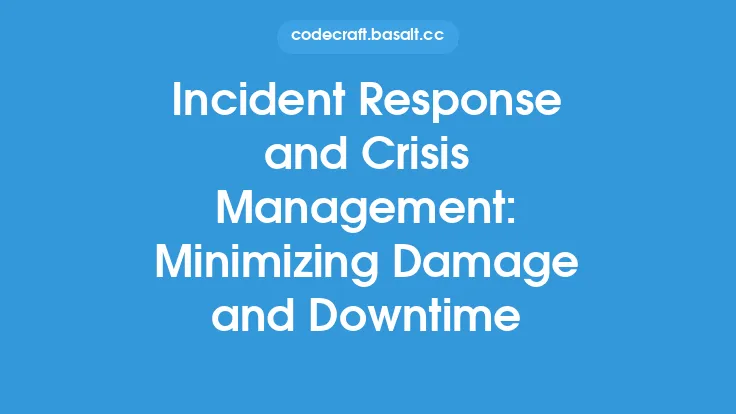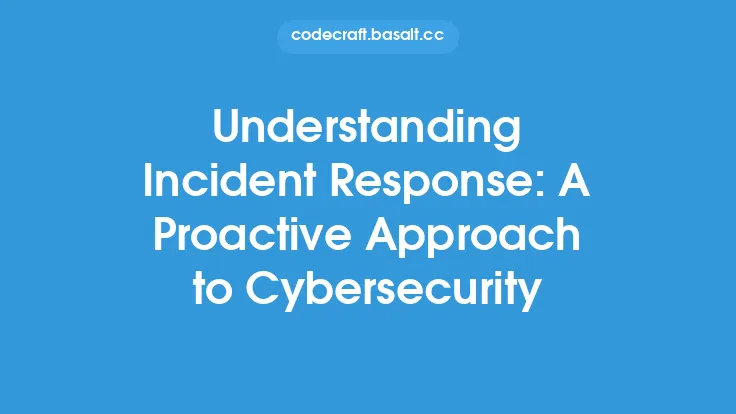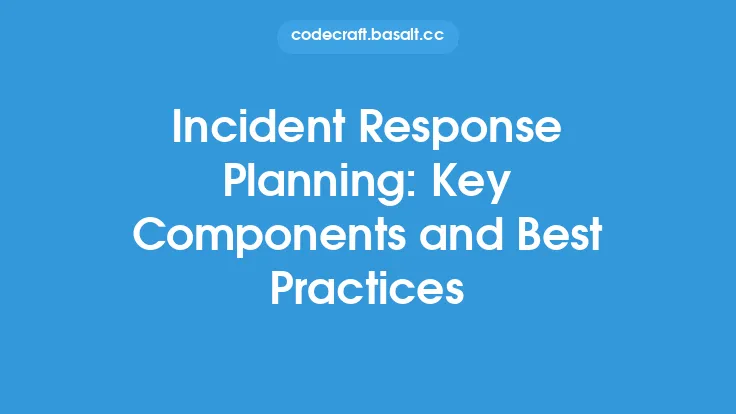Incident response is a critical component of an organization's cybersecurity posture, and it involves a series of activities aimed at responding to and managing the aftermath of a security incident. While the initial response to an incident is crucial, the post-incident activities are equally important, as they provide an opportunity for the organization to learn from the incident, identify areas for improvement, and implement measures to prevent similar incidents from occurring in the future. In this article, we will explore the importance of post-incident activities, including lessons learned and knowledge retention, and provide guidance on how organizations can effectively conduct these activities.
Introduction to Post-Incident Activities
Post-incident activities are a critical component of the incident response process, and they involve a series of tasks aimed at reviewing the incident, identifying lessons learned, and implementing measures to improve the organization's security posture. These activities are essential for ensuring that the organization learns from the incident and takes steps to prevent similar incidents from occurring in the future. Post-incident activities typically include a post-incident review, root cause analysis, and the implementation of corrective actions.
Conducting a Post-Incident Review
A post-incident review is a critical component of post-incident activities, and it involves a thorough review of the incident, including the events leading up to the incident, the response to the incident, and the aftermath of the incident. The review should identify the root cause of the incident, as well as any contributing factors, and should provide recommendations for improving the organization's security posture. The post-incident review should be conducted in a timely manner, ideally within 24-48 hours of the incident, and should involve all relevant stakeholders, including the incident response team, IT staff, and management.
Root Cause Analysis
Root cause analysis is a critical component of post-incident activities, and it involves identifying the underlying cause of the incident. This analysis should go beyond the immediate cause of the incident and should identify any underlying factors that contributed to the incident. Root cause analysis can be conducted using a variety of techniques, including the "5 Whys" method, which involves asking "why" five times to drill down to the root cause of the incident. The root cause analysis should provide a clear understanding of the incident and should identify areas for improvement.
Implementing Corrective Actions
Implementing corrective actions is a critical component of post-incident activities, and it involves taking steps to address the root cause of the incident and prevent similar incidents from occurring in the future. Corrective actions may include implementing new security controls, updating policies and procedures, and providing training to staff. The implementation of corrective actions should be prioritized based on risk, with the most critical actions being implemented first. The implementation of corrective actions should also be monitored and reviewed to ensure that they are effective and that the organization's security posture is improved.
Knowledge Retention
Knowledge retention is a critical component of post-incident activities, and it involves retaining the knowledge and lessons learned from the incident. This can be achieved through a variety of means, including documenting the incident, conducting training and exercises, and implementing a knowledge management system. The documentation of the incident should include a detailed description of the incident, the response to the incident, and the lessons learned. The documentation should also include any recommendations for improving the organization's security posture. Conducting training and exercises can help to ensure that staff are aware of the lessons learned and are prepared to respond to similar incidents in the future.
Lessons Learned
Lessons learned are a critical component of post-incident activities, and they involve identifying the key takeaways from the incident. Lessons learned should be documented and shared with all relevant stakeholders, including the incident response team, IT staff, and management. Lessons learned can be used to improve the organization's security posture and can help to prevent similar incidents from occurring in the future. Lessons learned may include the importance of timely communication, the need for effective incident response planning, and the importance of ongoing training and exercises.
Post-Incident Activities and Continuous Improvement
Post-incident activities are a critical component of continuous improvement, and they involve using the lessons learned from the incident to improve the organization's security posture. Continuous improvement involves ongoing monitoring and review of the organization's security controls and processes, as well as the implementation of new security controls and processes as needed. Post-incident activities can help to identify areas for improvement and can provide recommendations for implementing new security controls and processes. Continuous improvement can help to ensure that the organization's security posture is always improving and that the organization is prepared to respond to emerging threats.
Technical Considerations
From a technical perspective, post-incident activities may involve the use of a variety of tools and techniques, including incident response software, threat intelligence platforms, and security information and event management (SIEM) systems. Incident response software can help to automate the incident response process and can provide a centralized platform for managing incidents. Threat intelligence platforms can help to identify emerging threats and can provide real-time intelligence on potential security incidents. SIEM systems can help to monitor and analyze security-related data and can provide real-time alerts and notifications of potential security incidents.
Best Practices
Best practices for post-incident activities include conducting a thorough post-incident review, identifying the root cause of the incident, implementing corrective actions, and retaining knowledge and lessons learned. Organizations should also prioritize continuous improvement and should use the lessons learned from the incident to improve their security posture. Additionally, organizations should consider implementing a knowledge management system to retain knowledge and lessons learned, and should provide ongoing training and exercises to ensure that staff are prepared to respond to similar incidents in the future.
Conclusion
In conclusion, post-incident activities are a critical component of incident response, and they involve a series of tasks aimed at reviewing the incident, identifying lessons learned, and implementing measures to improve the organization's security posture. Organizations should prioritize post-incident activities and should use the lessons learned from the incident to improve their security posture. By conducting a thorough post-incident review, identifying the root cause of the incident, implementing corrective actions, and retaining knowledge and lessons learned, organizations can help to prevent similar incidents from occurring in the future and can ensure that their security posture is always improving.





